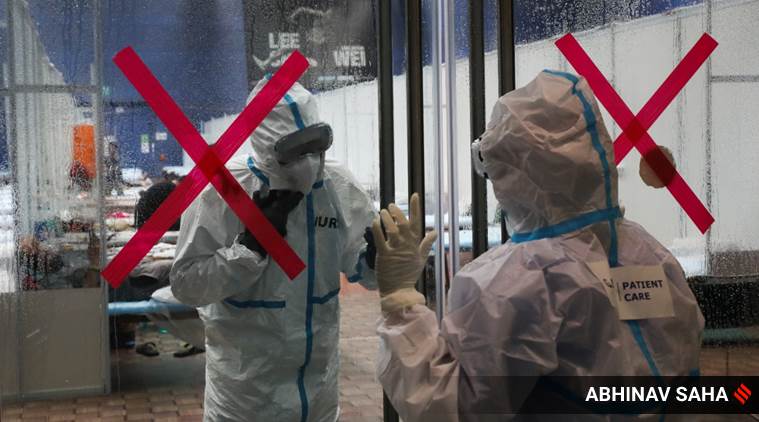 COVID care center at CWG Village maintained by an NGO and Delhi Government, a facility of 500 bed got 9 patients as of now, New Delhi, on Friday, July 10, 2020. (Express photo by Abhinav Saha)
COVID care center at CWG Village maintained by an NGO and Delhi Government, a facility of 500 bed got 9 patients as of now, New Delhi, on Friday, July 10, 2020. (Express photo by Abhinav Saha)
Four out of Delhi’s 11 districts account for over 70 per cent of people under complete lockdown inside containment zones, which have increased from around 260 in mid-June to 658 now, according to a report prepared by the Delhi government on July 12.
The report, accessed by The Indian Express, has been prepared as part of directions issued on June 15 to carry out a door-to-door survey in containment zones.
It shows that 71.33 per cent of 3,75,822 people residing in containment zones belong to four districts — south (79,113), southeast (77,072), central (58,517) and southwest (53,406).
On July 12, 56,133 out of the 3.75 lakh people living in containment zones across the city were surveyed.
The Southwest district leads the chart with 101 containment zones, closely trailed by West with 97 zones, and South with 75 zones. With 30, the Northeast district has the least number of containment zones.
At the 658 containment zones, a stricter lockdown and surveillance mechanism are mounted by the administration for tracing and isolating Covid cases and curbing its spread.
District Magistrate, Southwest, Rahul Singh sought to clarify that his district having the maximum containment zones does not mean it has the highest caseload: “More number of containment zones shows that the district is proactively dealing with the situation and containing the spread of the disease. At 43,044 tests since June 18, Southwest district has conducted the maximum number of rapid antigen tests in Delhi.”
The order to carry out the survey spelt out the need to capture data such as name, age, symptoms, if any, manually as well as through a mobile app. The objective was to identify all symptomatic persons, total number of persons tested, total number of those reported positive, among others.
“All Covid suspected persons in containment zones shall be visited by authorised personnel of the government, private sector or NGOs for further treatment/care… as per guidelines of the Ministry of Health and Family Welfare,” read the order issued by Divisional Commissioner Sanjeev Khirwar following a meeting chaired by Union Home Minister Amit Shah.
The mandate was also to ensure that everyone residing in those areas downloads the Aarogya Setu app.
The areas outside containment zones which are being surveyed include localities with cluster cases and isolated cases. Areas with isolated cases are those “regularly reporting isolated cases for 28 days and other areas (having infrequent isolated cases)”.
The government is also surveying high risk groups — senior citizens aged 60 or above and those with comorbid conditions such as hypertension, diabetes, cancer — and special surveillance groups, which include rickshaw, auto and cab drivers, domestic helps, plumbers, electricians, among others.